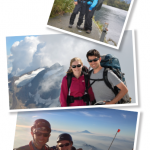Each physician had an interpreter. These young people were graduates of the Rokpa school where the group would be staying. Rokpa paid for them to be educated as physicians, but the Chinese will not let them practice.
The members of the group were required to bring whatever medications, materials, and equipment they would need to provide care upon arrival at the clinic. Dr. Fohrman and the others spent the two to three months prior to the trip gathering samples from pharmaceutical companies and putting together various types of equipment. Everything had to be repackaged and brought into Tibet in luggage, sleeping bags, and other travel bags.
Because they have only squat toilets in Yushu, people with severe knee or hip problems aren’t able to use the toilets available to them. The group bought every portable toilet they could find, and then they went from store to store sitting on buckets to determine which ones would support the weight of an adult and could be used as toilets.
There were not enough anti-inflammatories to provide a year’s supply to everyone, and there would be no follow-up care when the medical team went home. Dr. Fohrman had the foresight to take a large number of injectable steroids and needles with him, knowing he could provide at least several months’ relief to these individuals by injecting joints.
The clinic was able to service 60 to 75 people per day. Each day, anywhere from 100 to 300 people showed up at the gate asking for medical attention. The team implemented a “ticket” system—the staff would go out into the crowd an hour or so before the clinic opened and give tickets to individuals they thought would benefit most from the care they were able to provide. People became somewhat frantic, pushing at the gate and trying to enter through the back door. Dr. Fohrman states, “It was extremely stressful having to turn people away who so obviously needed our help.”
Dr. Fohrman went to Tibet with the intent that he would practice primarily internal medicine there, but he spent the majority of his time seeing people with arthritis. The Tibetan people live a nomadic and agrarian lifestyle. They don’t have cars or buses and when painful arthritis renders an individual incapable of walking or climbing hills, it seriously hinders his or her lifestyle.
Eighteen-year-old Ariel spent a great deal of time working with the group’s occupational therapist fashioning a walker out of shovel handles and wheels from old walkers. During its visit, the group was able to build walkers for two children who had previously been unable to get around on their own.
